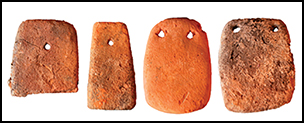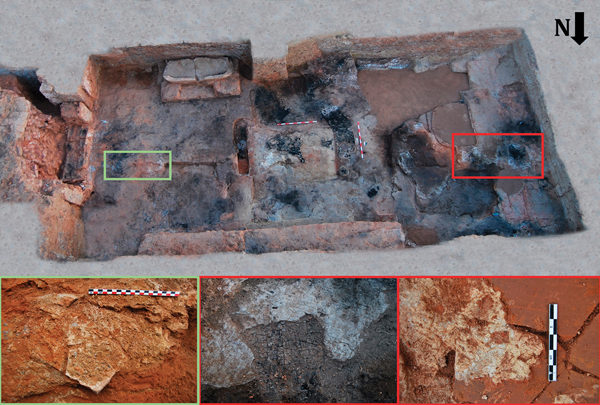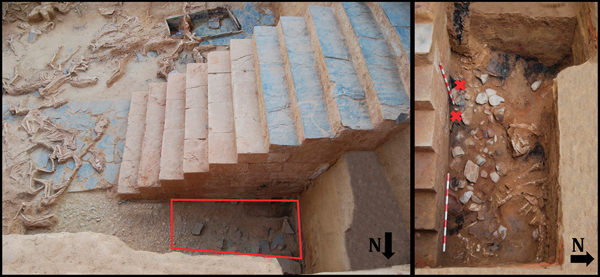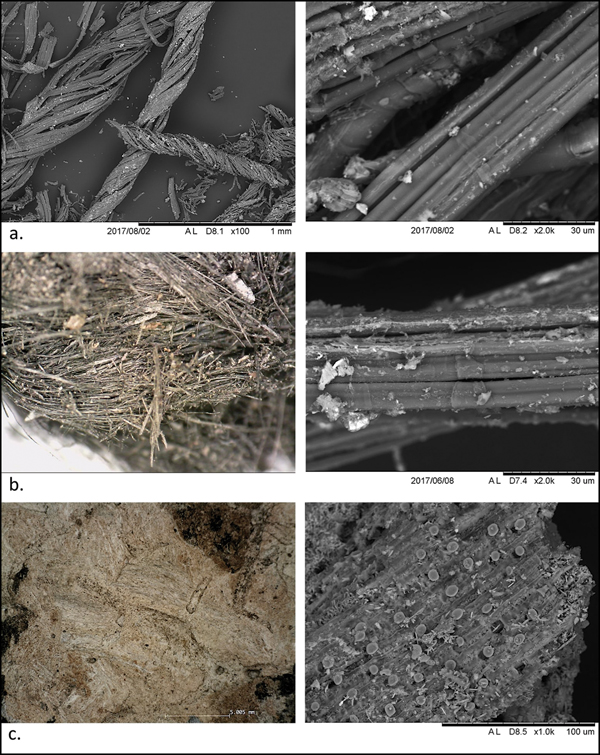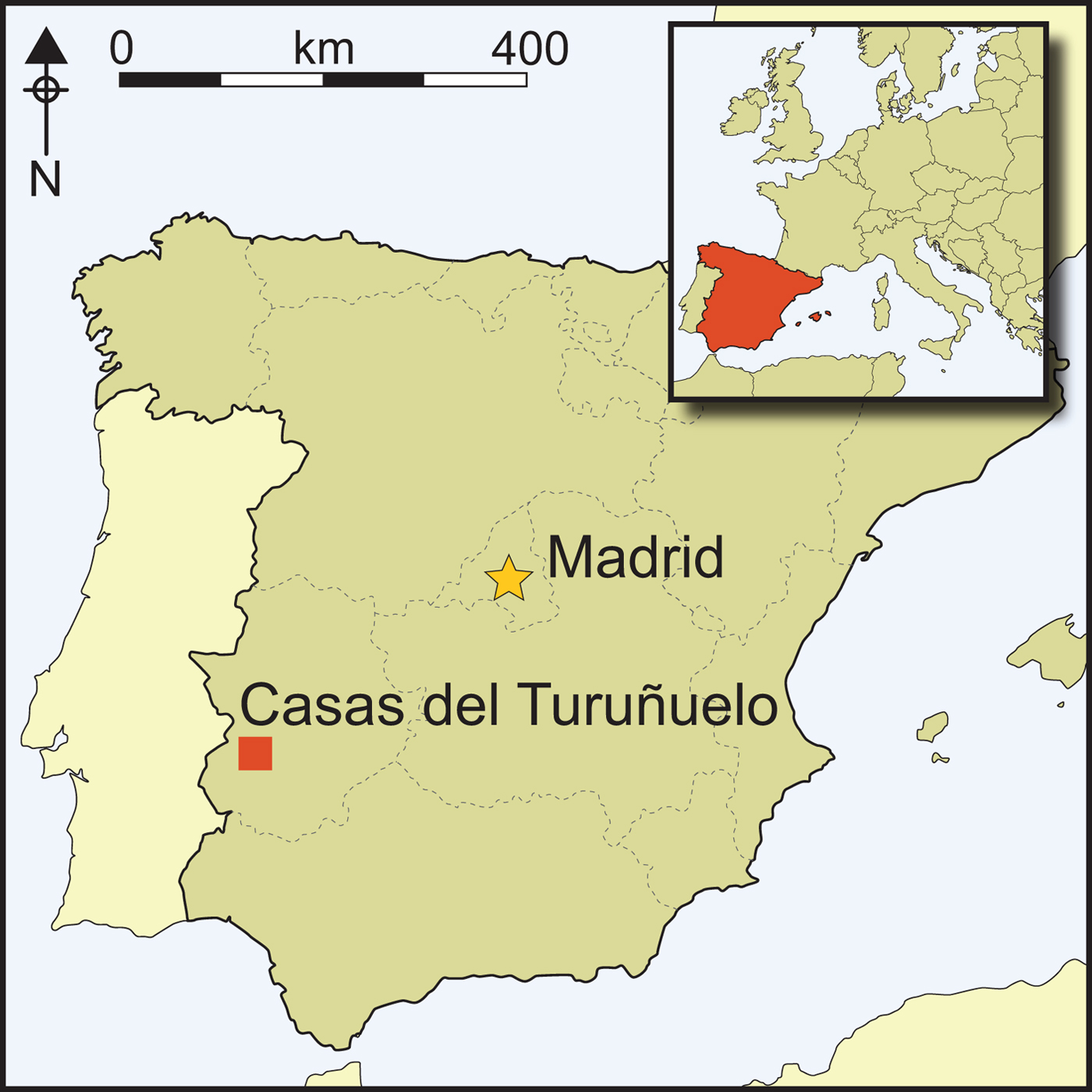
Introduction
Casas del Turuñuelo is located in the High Guadiana Meadows in Badajoz, south-western Spain. The site is an Iron Age rural estate centre comprising a large, two-storey building with adobe walls on stone foundations, surrounded by grounds constructed in the early sixth century BC. The site was abandoned in the late fifth century BC, when the complex was intentionally set on fire and subsequently covered with a mound (Figure 1a–d). Since 2014, excavations have uncovered evidence for the sacrifice of a large number of animals in the lower level of the building, prior to its destruction by fire. A great staircase provided access to the upper part of the building where Room 100 served a ritual function, with the latter focused on an oxhide-shaped altar in the centre of the room and a long bench along its north wall.
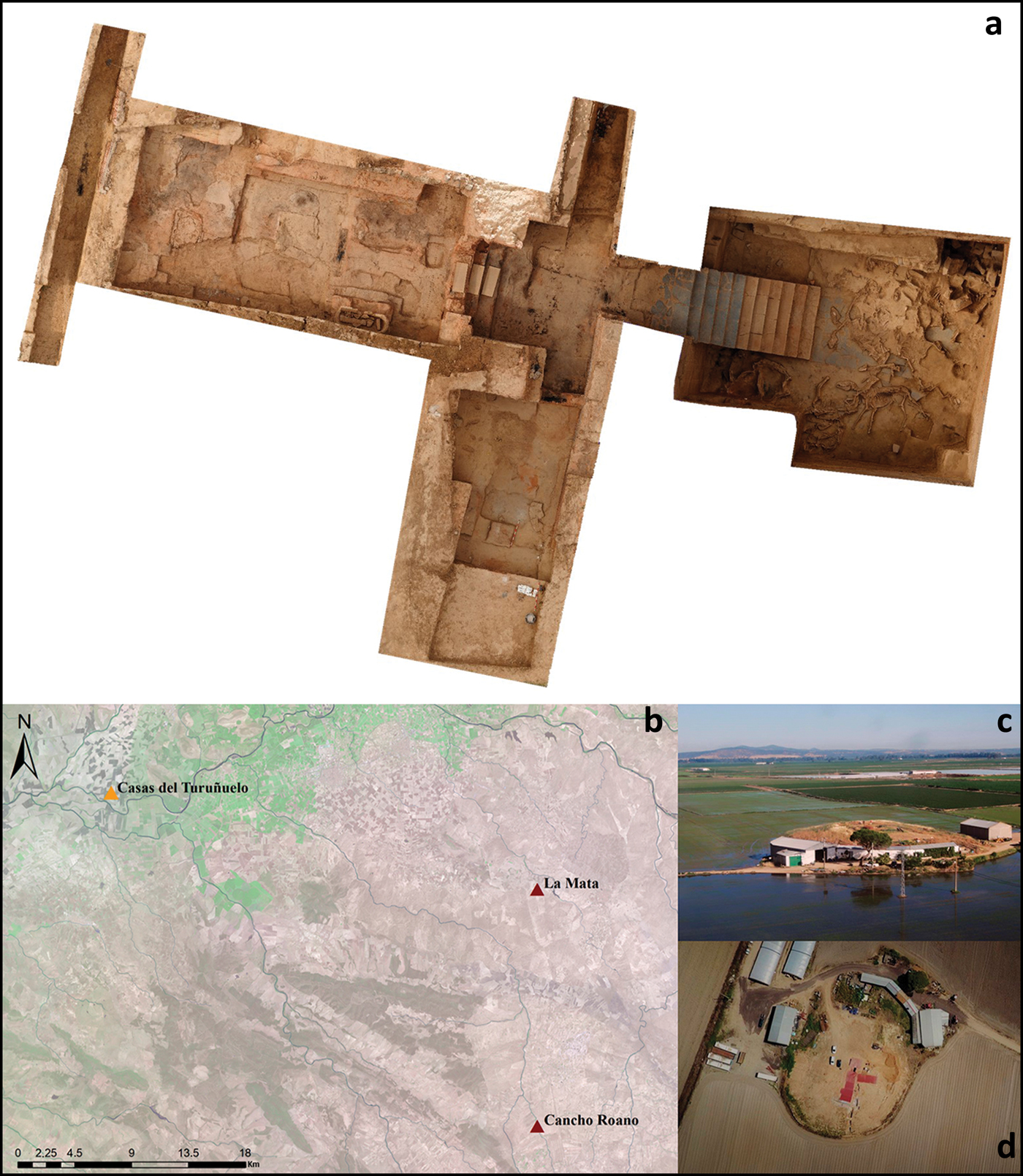
Figure 1. The site of Casas del Turuñuelo: a) aerial view of the building; b) map of the region; c) view of the site from the Guadiana River; d) aerial view of the site (figure by E. Rodríguez).
Casas del Turuñuelo resembles and is related to the well-known sites of Cancho Roano and La Mata (Rodríguez Díaz Reference Rodríguez-Díaz, Knapp and van Dommelen2014; Celestino & López-Ruiz Reference Celestino and López-Ruiz2016: 211–53), located only 45km distant (Figure 1b). Cancho Roano and La Mata were also large country estates that included residential, production, storage and ritual areas. The three sites had easy access to interregional and Eastern Mediterranean trade routes; they were well connected with Andalusia to the south and the Alentejo region in Portugal to the west, where Phoenicians founded several settlements from the ninth century BC onwards. Indeed, similar country estates with clear evidence of Phoenician-Punic influence have been excavated in both Andalusia and Portugal (Arruda & Celestino Reference Arruda, Celestino, Mateos, Celestino, Pizzo and Tortosa2009; Jiménez Ávila Reference Jiménez-Ávila2009; Escacena & Coto Reference Escacena and Coto2010; Rodríguez Díaz Reference Rodríguez-Díaz, Knapp and van Dommelen2014). Casas del Turuñuelo, however, is unique due to the presence of the animal sacrifice and the associated charred textiles and fibres presented here. The latter constitute the largest assemblage of its kind found to date in an Iberian Iron Age context. Alongside the textiles, 24 spindle whorls and 36 loom weights were also found, providing a compelling case study for the analysis of textile production and ritual consumption in Iron Age south-western Iberia. Most importantly, the site provides information concerning the role of textiles in ritual—particularly the Iron Age sacrificial economy—beyond classical Greece and Rome, and the Eastern and Central Mediterranean (Wengrow Reference Wengrow, Wilkinson, Bennet and Sherratt2011; Gleba Reference Gleba, Kistler, Öhlinger, Mohr and Hoernes2015; Brøns Reference Brøns2017; Brøns & Nosch Reference Brøns and Nosch2017).
The sacrifice deposits are, to date, unique in the Mediterranean region. They derive from a large banquet in the South Room of the upper part of the building, as attested by the recovery of hundreds of ceramic vessels, as well as bronze braziers, and the ritual burning of an ovicaprid on the altar in Room 100 (Rodríguez-González & Celestino Reference Rodríguez-González and Celestino2017). A large number of animals—52 horses (Equus ferus caballus), four cows (Bos taurus), four pigs (Sus scrofa domestica) and a dog (Canis lupus familiaris)—were slaughtered and deposited in the lower level of the residence. The articulated nature of the carcasses shows that they were not consumed as part of the banquet. These animals were burned as part of the sacrifice that took place in the building, together with more than a dozen amphorae (some containing cereals), Greek, Punic and fine local pottery and ivory plaques (Rodríguez-González & Celestino Reference Rodríguez-González and Celestino2017), as well as the textiles that we present below. The sacrificial destruction of Casas del Turuñuelo in the late fifth century BC represents a significant and costly act that involved large quantities of valuable objects, materials and animals being taken out of circulation.
The survival of textiles, mats and textile-working tools at the site provides unique insights into the technical and technological characteristics of textiles in Iberia, and contributes to the study of the ritual use of textiles in the wider ancient Mediterranean. This article presents these important new finds for the first time, before discussing their significance for our understanding of the ritual production of textiles, Iron Age offerings and the sacrificial economy in late prehistoric Europe.
Materials
Textiles and mats
The textile and fibre remains were recovered during the 2016 and 2017 excavation seasons at Casas del Turuñuelo. The first batch of samples was found in the upper floor of the building (stratum UE 112). This comprised the remains of mats made from esparto grass (Stipa tenacissima) or related monocot species, located on several areas on the floor (Figure 2); textile fragments and barley seeds were also found inside a grey ware vessel (Figure 3) situated in the anteroom at the entrance to Room 100 (UE 515) (Rodríguez-González & Celestino Reference Rodríguez-González and Celestino2017: 191). The second series of textiles was recovered on the lower floor, immediately adjacent to the great staircase, together with three glazed vessels of Phoenician-Punic style (UE 606) (Figure 4).
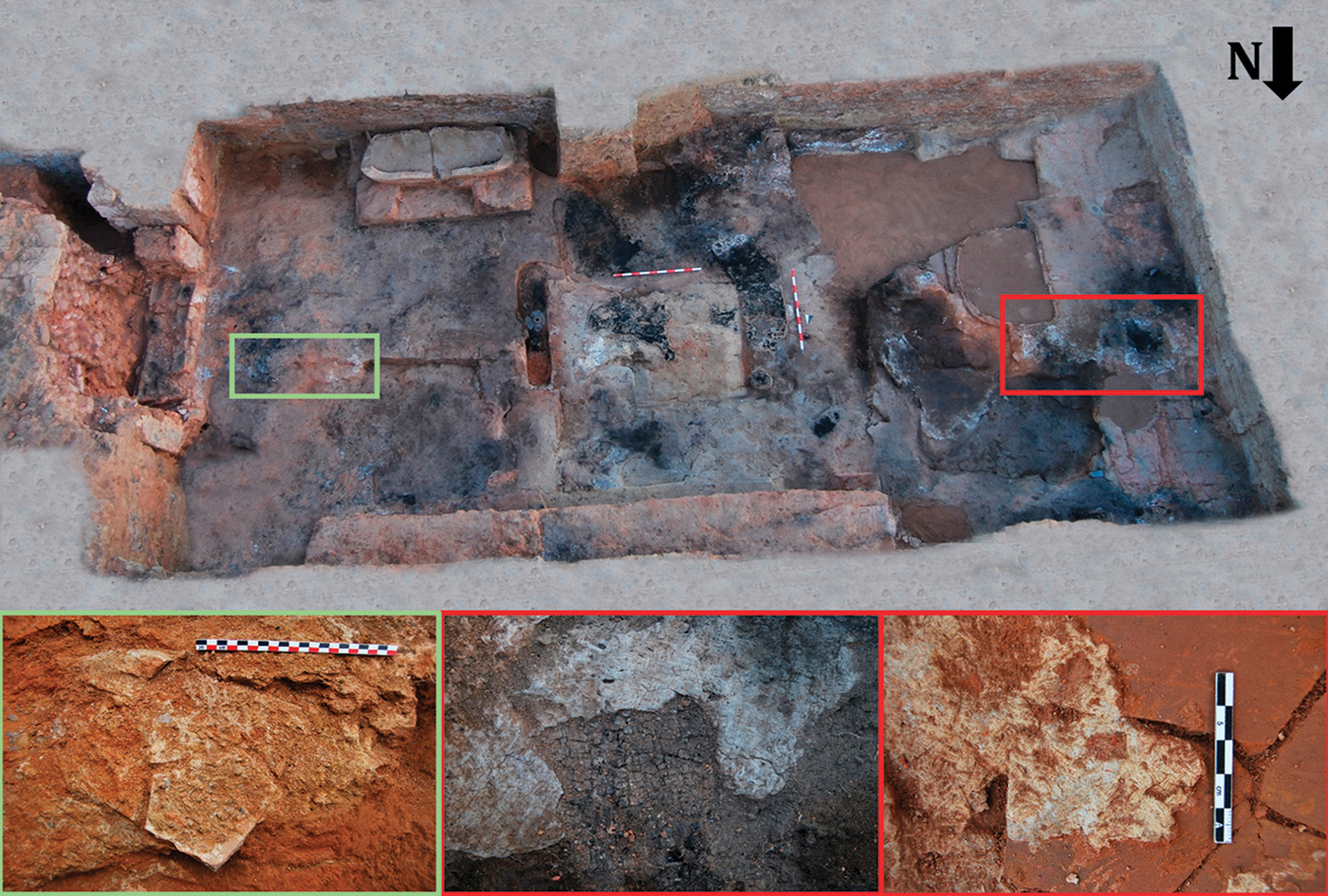
Figure 2. Top) aerial view of the upper floor with locations of esparto grass matting indicated; bottom) close-up photographs of the esparto matting (figure by E. Rodríguez).
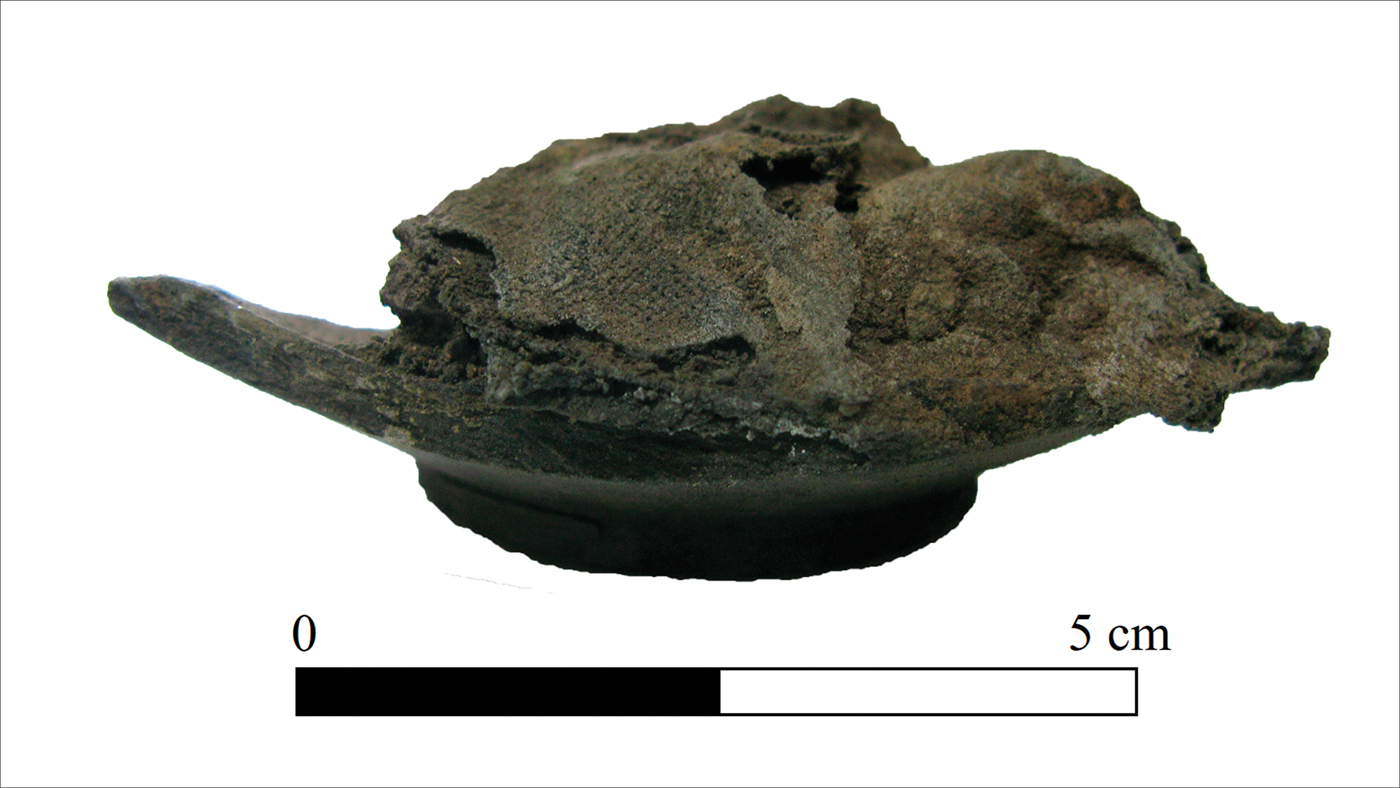
Figure 3. Grey ware vessel containing remains of the textile and barley seeds (figure by E. Rodríguez).
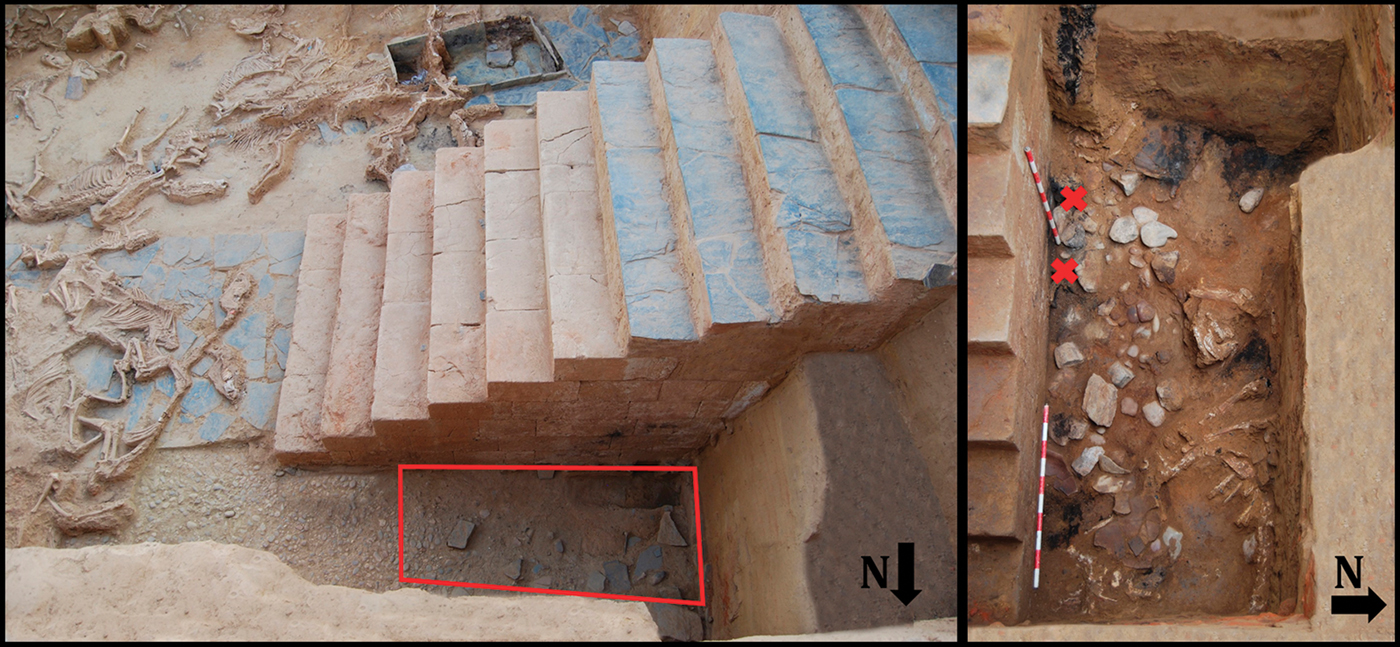
Figure 4. Views of the lower floor; findspots of textiles and fibres near the monumental staircase are indicated on the left, with a close-up of the area on the right (figure by E. Rodríguez).
Textile characterisation includes the determination of structural parameters, such as thread twist, diameter and angle; weave and thread count per centimetre (indicative of textile quality); and the presence of edges and any other distinctive elements, such as pattern and sewing (Emery Reference Emery2009). Structural analysis was performed using a portable Dino-Lite digital microscope at 20×, 50× and 230× magnifications. Fibres were identified using a Hitachi TM3000 TableTop scanning electron microscope, using Margarita Gleba's reference collection for comparison.
The assemblage includes at least four different types of fabric (Table 1). Two are woven in plain or tabby weave (Figure 5a–b); this is the simplest loom-based structure, with both weft and warp threads going one under and one over. The tabbies are both relatively balanced, with approximately the same number of threads per unit of length, and are of similar quality. Both tabbies are made of plant fibre, probably flax.
Table 1. Technical textile data (thread counts are in threads per centimetre; * indicates splicing; angle measurements according to Emery Reference Emery2009: 12).


Figure 5. Scanning electron micrographs of textiles found at Casas del Turuñuelo: a) linen tabby from UE 515; b) linen tabby from UE 606; c) 2/2 twill from UE 606; d) 2/1 twill from UE 606 (figure by M. Gleba).
The other two textiles are twills (Figure 5c–d). In an even 2/2 twill weave, each warp thread goes over two weft threads, then under two, with an offset in each row forming a diagonal pattern (Emery Reference Emery2009: 92). In a 2/1 twill, the weft goes under two warp threads, then over one, while the warp goes over two wefts and under one (Emery Reference Emery2009: 99). One of the Casas del Turuñuelo twills is a diagonal 2/2 twill woven with clockwise-, or z-twisted, yarn in one system and counter-clockwise-, or s-twisted, yarn in the other. The fabric had no preserved edges, so the direction of warp and weft cannot be determined. The second twill is a 2/1 lozenge twill, woven in yarn that was z-twisted and S-plied (two single z-twisted threads twisted together in an ‘S’ direction together to form a stronger, doubled yarn). Two fragments of this type were recovered from the lower floor and probably belong to the same textile. They are of exceptional quality in terms of thread count, with 30 warp threads per centimetre and 40 weft threads per centimetre; other archaeologically documented twills from Italy and Central Europe usually range between 15–25 threads per centimetre (Banck-Burgess Reference Banck-Burgess2012: 51; Grömer et al. Reference Grömer, Kern, Reschreiter and Rösel-Mautendorfer2013: 64; Gleba Reference Gleba2017: 1210). Both twills are made of sheep wool, which was combed or otherwise manually processed, as indicated by the presence of parallel fibres with cuticular scales aligned in opposite directions. Despite processing, some of the thicker fibres are still present (Figure 5d: right).
In addition to the textiles, an unidentifiable object comprising what appear to be z-twisted linen threads was recovered from the same context (Figure 6a) as the two twills. The threads are unusual in that the fibres are not separated but cling together in ribbons. This feature is typical for spliced yarn, which is made by removing fibre ribbons from the plant and then twisting them together either continuously, or at the ends (Gleba & Harris Reference Gleba and Harris2018). Spliced yarns are inherently unstable and have to be plied, yet the threads appear to be single rather than plied, which suggests that the object in question may have been a skein, or ball, of semi-finished yarn. Finally, at least three accumulations of fine, plant, bast fibres (probably flax) were found with the wool textiles (Figure 6b).
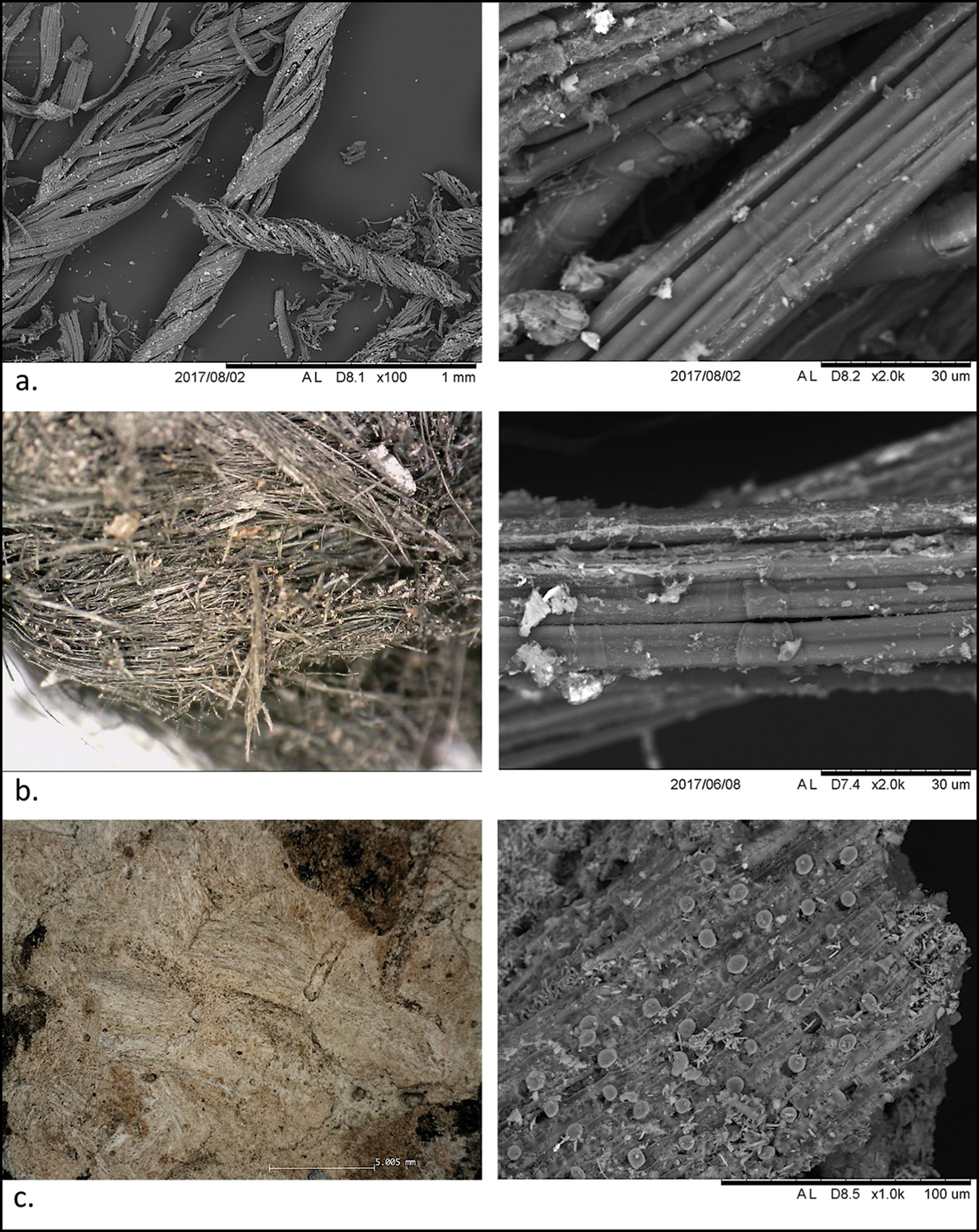
Figure 6. Digital and scanning electron micrographs of threads and fibres found at Casas del Turuñuelo: a) spliced linen threads from UE 606; b) flax fibre bundles from UE 606; c) esparto grass from UE 112 (figure by M. Gleba & B. Marín-Aguilera).
Textile tools
Textile tools recovered at Casas del Turuñuelo include 24 spindle whorls and 36 loom weights (Figure 7). Both types of tools were recovered from the anteroom of the upper floor. Some spindle whorls were also found in the South Room, where the sumptuous banquet took place, and on the lower floor, to the right of the stairs in association with the textiles (Figure 8). The analysis of textile tools provides important information about textile production. The functional characteristics of spindle whorls and loom weights, for example, allows a reconstruction of the type of thread that was spun and the quality of the resulting cloth by studying the functional characteristics of spindle whorls and loom weights (Mårtensson et al. Reference Mårtensson, Nosch and Strand2009; Andersson Strand & Nosch Reference Andersson Strand and Nosch2015). The rare survival of textile fragments at Casas del Turuñuelo permits a comparison of the evidence provided by analysis of both the structural characteristics of the textiles and the textile tools.
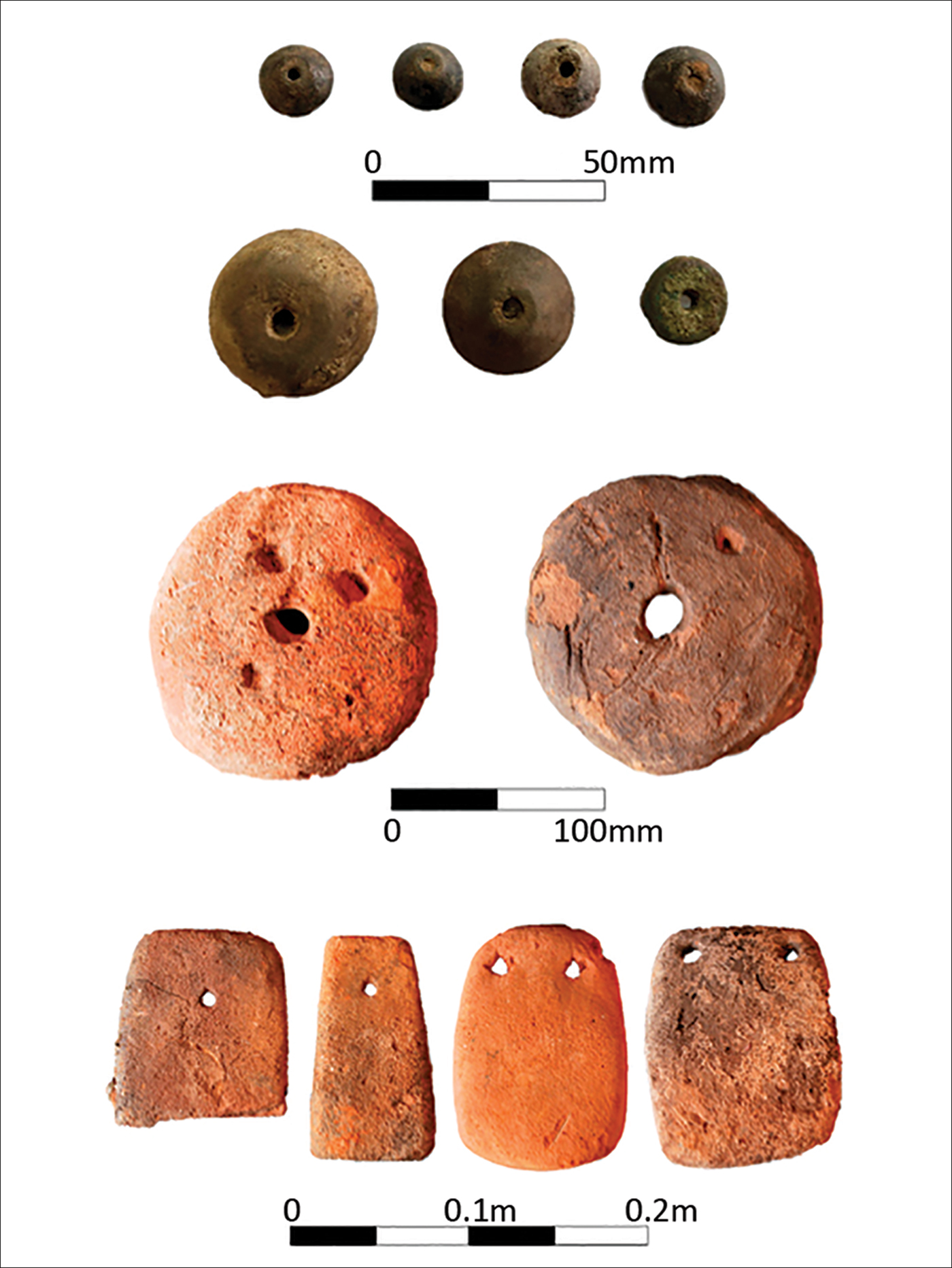
Figure 7. Spindle whorls and loom weights from Casas del Turuñuelo (figure by E. Rodríguez).

Figure 8. Site map showing the distribution of textile tools (figure by E. Rodríguez).
Spindle whorls
A spindle whorl is a small symmetrical object with a central perforation. The whorl is inserted onto a spindle in order to facilitate the spinning of fibres into thread (Barber Reference Barber1991: 51–53). Spindles are used for draft spinning raw fibres, such as wool or flax, by simultaneously drafting and twisting them. The weight, diameter and shape of a spindle whorl determine the thickness and twist angle of the resulting thread and, hence, its quality (Grömer Reference Grömer, Bichler, Grömer, Keijer, Kern and Reschreiter2005; Mårtensson et al. Reference Mårtensson, Nosch and Strand2009: 374).
The 24 spindle whorls found at Casas del Turuñuelo are light, weighing from 1–27g (Figure 9). Most weigh less than 14g and have a maximum diameter of less than 31mm; they would have been suitable for spinning very fine (1–7g) and fine (8–12g) thread (Mårtensson et al. Reference Mårtensson, Nosch and Strand2009). Figure 9 shows that spindle whorls excavated at Casas del Turuñuelo are comparable in weight and size to those recovered from the contemporaneous settlements of Cancho Roano and La Mata (Berrocal-Rangel Reference Berrocal-Rangel and Celestino2003; Marín-Aguilera Reference Marín-Aguilerain press).
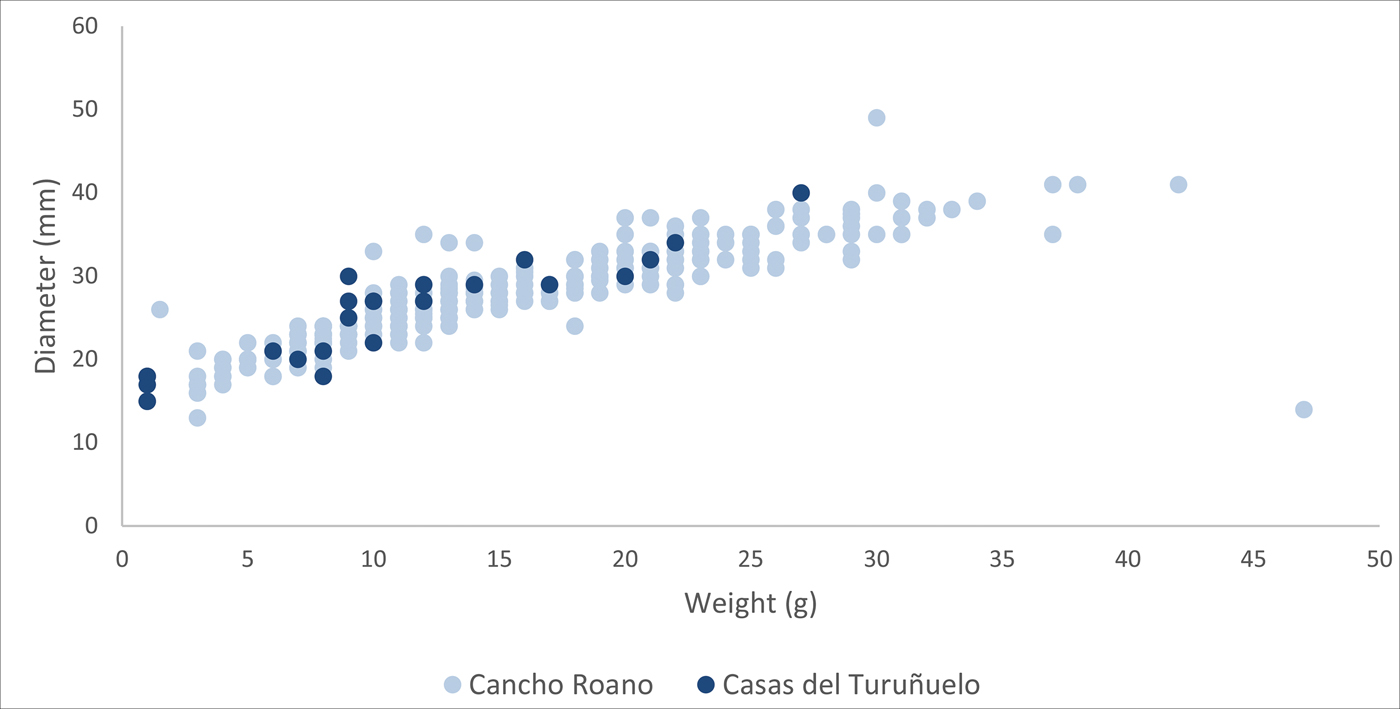
Figure 9. Scatter plot of spindle whorls from Casas del Turuñuelo (with Cancho Roano spindle whorls for comparison) (figure by B. Marín-Aguilera).
Loom weights
Loom weights are used to keep sets of warp threads taut in a vertical warp-weighted loom—the prevalent type of loom in pre-Roman Europe (Barber Reference Barber1991: 93–113). The tension created by the loom weights facilitates the insertion of the horizontal weft threads. Warp threads of different material, diameter and strength require different tensions for optimal weaving. Loom weights of different weight and thickness are therefore suitable for different types of weaves.
Archaeological experiments have yielded valuable information regarding the functional properties of loom weights (Mårtensson et al. Reference Mårtensson, Nosch and Strand2009: 392). The number of warp threads, for example, that can be attached to a loom weight ranges between 5 and 50, depending on the type of textile being woven (Lena Hammarlund pers. comm.). Although the diameter of the thread determines the appropriate tension, other important parameters include how tightly the thread was spun and the type and quality of fibre (Andersson Strand Reference Andersson Strand, Michel and Nosch2010: 18; Grömer Reference Grömer2016: 112). Thus, thick and thin threads require different tensions in the loom, which are attained by using lighter or heavier weights, and/or by varying the number of threads per loom weight.
The shape of the loom weight is also important for achieving higher or lower thread density. Discoid and pyramidal loom weights—the predominant types at Casas del Turuñuelo (Figure 10)—require less space than spherical weights when set in a row, and are therefore suitable for the production of denser textiles. Most of the loom weights from Casas del Turuñuelo weigh less than 800g, with two groups distinguishable between 200–400g and 550–750g, respectively. This would have allowed for the production of a variety of textiles. Calculations were made for the three weaving techniques identified in the Casas del Turuñuelo's textiles—tabby, 2/1 twill and 2/2 twill (Tables 2–4)—following the method developed by the Centre for Textile Research in Copenhagen (Mårtensson et al. Reference Mårtensson, Nosch and Strand2009: 392; Andersson Strand & Nosch Reference Andersson Strand and Nosch2015). As a result of Lena Hammarlund's experiments, however, we have increased the number of threads per loom weight from 40 to 50.
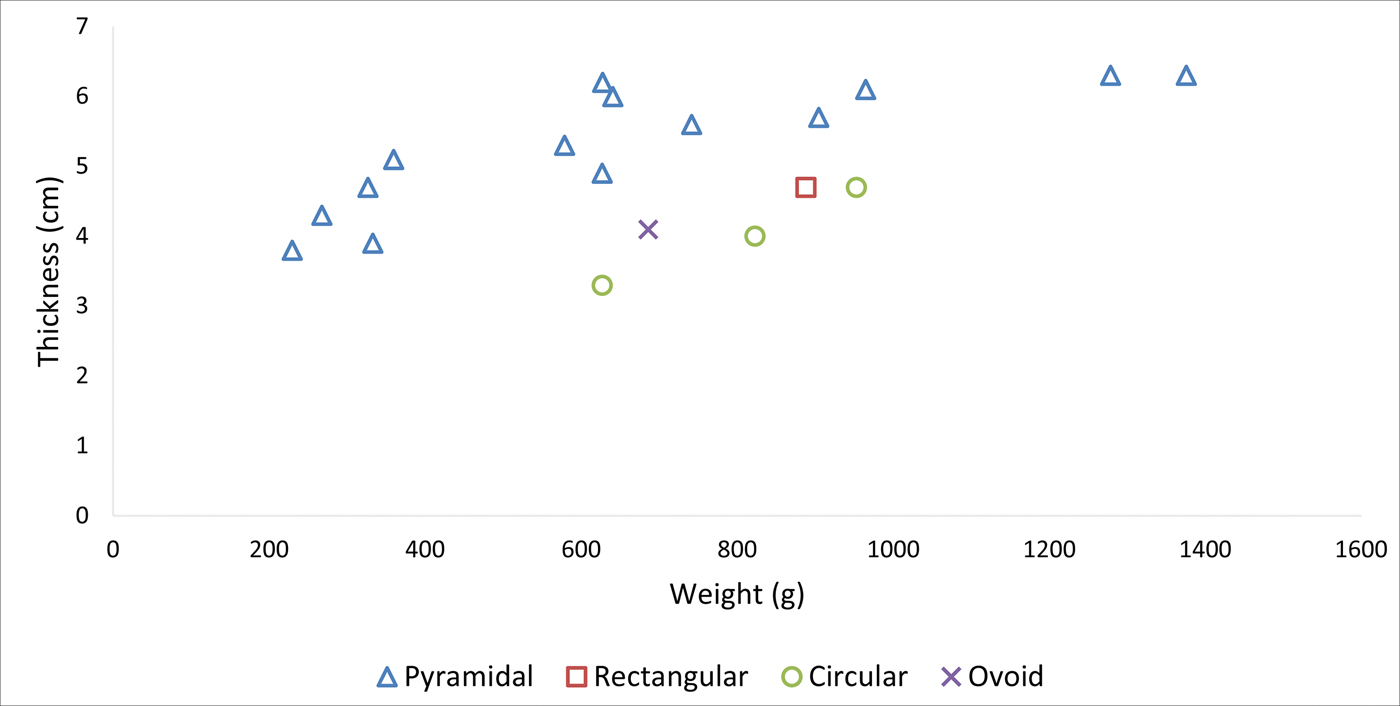
Figure 10. Scatter plot of loom weights from Casas del Turuñuelo (figure by B. Marín-Aguilera).
Table 2. Loom weight calculations for tabby weave, 2/1 twill and 2/2 twill, with the smallest loom weight found at Casas del Turuñuelo.
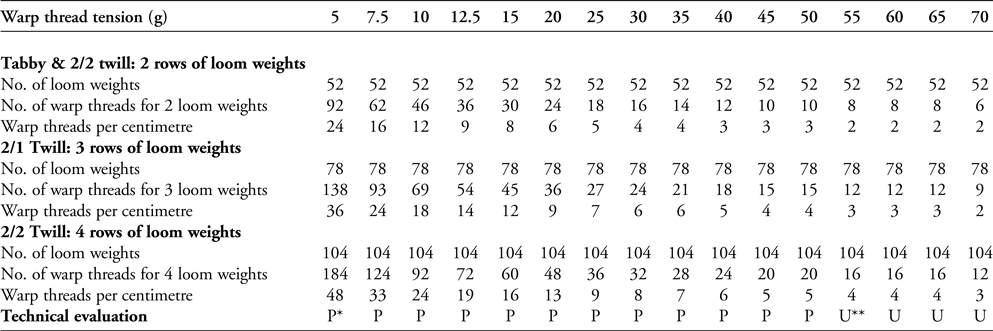
* P = Possible.
** U = Unlikely.
Table 3. Loom weight calculations for tabby weave, 2/1 twill and 2/2 twill, with the medium loom weight found at Casas del Turuñuelo.

* P = Possible.
** U = Unlikely.
Table 4. Loom weight calculations for tabby weave, 2/1 twill and 2/2 twill, with the largest loom weight found at Casas del Turuñuelo.

* P = Possible.
** U = Unlikely.
The results of this functional tool analysis demonstrate that all of the textiles found at Casas del Turuñuelo could have been produced using the loom weights excavated at the site. Given the uniqueness of the site and its deliberate destruction and burial, the set of tools probably reflects the entire original assemblage. Excavations, however, are continuing and additional textile tools may yet be found.
Discussion
Casas del Turuñuelo is the first site in Iron Age Iberia for which the analysis of textile tools can be combined with the analysis of surviving textiles. Moreover, the site has yielded the first-known evidence for wool twill textiles in the entire Iberian Peninsula, contributing new information to the current debate on the existence of different ‘textiles cultures’ across ancient Europe (Gleba Reference Gleba2017). Most importantly, Casas del Turuñuelo provides a rich and revealing window into the role of textiles in rituals and the sacrificial economies of the ancient Mediterranean.
The textile and fibre assemblage recovered at Casas del Turuñuelo is, to date, unique in Iberia in its variety of raw materials. The esparto grass mats found on the upper floor of the building were possibly used to even out the floor surface (see Figure 7). The linen tabby found inside a grey ware vessel may have been part of a linen bag containing barley seeds as a ritual offering (Rodríguez-González & Celestino Reference Rodríguez-González and Celestino2017: 191). The tabby textiles, the spliced yarn and the fibre accumulations are all probably made of flax—a plant introduced to the Iberian Peninsula by the early third millennium BC (Jover & López Reference Jover and López2013: 150). Linen textiles have also been found at the Chalcolithic cave of Cueva Sagrada I at Lorca and in the numerous Bronze Age burials of the Los Millares and Argaric Cultures (Alfaro Reference Alfaro1984, Reference Alfaro and Eiroa2005; Jover & López Reference Jover and López2013). While the Chalcolithic and Bronze Age Iberian linen textiles all appear to be woven with spliced yarn, the fifth- to fourth-century BC finds from Cadiz, La Albufereta and El Cigarralejo have draft-spun yarn (Alfaro Reference Alfaro1983, Reference Alfaro1984: 119–21, 138–41; Verdú Reference Verdú2015: 417–18). They are also directly comparable to the two Casas del Turuñuelo linen fragments in terms of weave structure (relatively balanced tabby), twist direction (mostly z-twist) and thread count, which ranges between 10 and 30 threads per centimetre in both systems. The presence of possibly spliced plant fibre threads at Casas del Turuñuelo suggests that the site witnessed the transition between splicing and draft-spinning technologies—a change that corresponds with transition seen in other parts of the Mediterranean after 600 BC (Gleba & Harris Reference Gleba and Harris2018).
In contrast to plant fibres, there is currently little direct evidence for the pre-Roman exploitation of animal-based fibres in the Iberian Peninsula. Until now, the earliest wool textile identified in Iberia was recovered at an Iberian-culture sanctuary in Murcia and is dated to the second century BC (Alfaro & Ocharan Reference Alfaro, Ocharan, Ferrando and Costa2014). The presence of wool has been suggested in the Bronze Age Tomb 121 of the so-called ‘Man of Galera’ at Castellón Alto (Molina et al. Reference Molina, Rodríguez-Ariza, Jiménez and Botella2003: 157). Until scientific analysis of this material is published, however, the textile finds from Casas del Turuñuelo represent the earliest irrefutable evidence for the use of sheep wool in Iberia.
The wool textiles found at Casas del Turuñuelo are woven in twill weave—a technique developed during the Bronze Age (Bender Jørgensen & Rast Eicher Reference Bender Jørgensen and Rast-Echer2016: 86). The flexibility of wool makes it more suitable than plant fibres for twill weaving. The only other 2/2 twill fragments found so far in pre-Roman Iberia are from La Albufereta and date to the fourth century BC. They are woven in z-twisted yarn and have 8–10 threads per centimetre in both the warp and weft systems, being somewhat coarser than the 2/2 twill from Casas del Turuñuelo (Alfaro Reference Alfaro1984: 147–48, numbers 127–31; Verdú Reference Verdú2015: 417–18). While 2/2 twills woven in z-twisted yarn are common across first-millennium BC Italy and Central Europe (Grömer et al. Reference Grömer, Kern, Reschreiter and Rösel-Mautendorfer2013; Gleba Reference Gleba2017), z/s twills are relatively rare. Several fragments of wool z/s 2/2 twills were found in a mine at Irun (Roman Oiasso) in the Basque Country, and are dated by association with ceramics to AD 50–150 (Alfaro Reference Alfaro, Bergerbrant and Fossøy2014). Closer in date to Casas del Turuñuelo are examples of fifth-century BC z/s 2/2 twills from burial contexts in central and eastern France (Milcent & Moulherat Reference Milcent, Moulherat, Villes and Bataille2000: 314; Verger et al. Reference Verger, Milcent, Moulherat, Maranski and Guichard2002: 124–27).
The 2/1 twill woven in plied yarn in both systems found at Casas del Turuñuelo is unusual. While this example is so far unique for Spain, fifth-century BC comparisons are found, again, in France, where 2/2 and 2/1 twills woven with plied yarn in both systems have been documented at several sites—although none are as fine as the Casas del Turuñuelo twill (Milcent & Moulherat Reference Milcent, Moulherat, Villes and Bataille2000: 314). While twills woven in single yarn are typical for Italy and the Eastern Hallstatt area of Central Europe (eastern Austria, Slovenia, Croatia), the Western Hallstatt region (western Austria, western Germany and France) favoured twills with plied warp and single weft (Banck-Burgess Reference Banck-Burgess2012: 61). Plying of the warp may have been a response to a lack of suitable (long) wool fibre in the Western Hallstatt region (Rast Eicher & Bender Jørgensen Reference Rast-Eicher and Jørgensen2013: 1231). The twills from Casas del Turuñuelo therefore best resemble the material from the Western Hallstatt region.
Textile tool analysis indicates that all of the textiles found at Casas del Turuñuelo could have been produced at the site. The presence of unfinished spliced yarn and fibre accumulations further support the local production of the textiles found on site. Nevertheless, compared to the more specialised textile production at Cancho Roano (Marín-Aguilera Reference Marín-Aguilerain press), the manufacture of textiles at Casas del Turuñuelo—based on the number of loom weights (36) recovered from within the building—appears to have been primarily domestic. It is possible that spinners and weavers were working at the site specifically for the occasion of the final banquet, and that the precious textiles they manufactured, together with their tools, were later included in the sacrifice. The ritual production of textiles at Casas del Turuñuelo is not exceptional in the region; it is also documented at La Mata and Cancho Roano (Marín-Aguilera Reference Marín-Aguilerain press). On a broader scale, there is ample textual and archaeological evidence for this phenomenon in Italy, Greece and the Near East (Gleba Reference Gleba, Kistler, Öhlinger, Mohr and Hoernes2015; Brøns & Nosch Reference Brøns and Nosch2017). In contrast to those regions, however, the textiles at Casas del Turuñuelo were sacrificed and destroyed. Thus, they were taken out of circulation, rather than dedicated and ‘archived’ at a sanctuary (Brøns Reference Brøns2017)—an act that would have allowed the wealth to be reintroduced into circulation (Wengrow Reference Wengrow, Wilkinson, Bennet and Sherratt2011).
The site's material culture and architecture more closely resemble Phoenician rituals and practices, with which the inhabitants of the Iberian Peninsula were familiar through interregional trade routes. Inscriptions from Carthage and Marseilles indicate the practice of zbḥ, which simultaneously translates as ‘offering’ and ‘sacrifice’ in the Phoenician and Punic world (Amadasi Reference Amadasi and Zamora2003: 49–51). Such rituals included a banquet during which meat, cereals, oil and wine were consumed, animals were slaughtered to honour the gods, and precious objects, such as textiles and garments, were consecrated. All these elements have been found at Casas del Turuñuelo, including ivory plaques with gold appliqués of clear Eastern influence (Rodríguez-González & Celestino Reference Rodríguez-González and Celestino2017: 190).
Conclusions
The exceptional preservation of both textiles and tools at Casas del Turuñuelo provides a unique glimpse of textile production and offerings connected to ritual sacrifice in fifth-century BC Iberia. While the quantity of tools at Cancho Roano attests a greater emphasis on the production of textiles in a ritual context (Marín-Aguilera Reference Marín-Aguilerain press), the discovery of the textiles themselves at Casas del Turuñuelo demonstrates—for the first time in pre-Roman Iberia—their use as ritual offerings. Textiles with very fine threads and high thread counts, such as those recovered at Casas del Turuñuelo, were extremely valuable, as they required high-quality raw materials and substantial time and skill to produce (Harris Reference Harris2018). Wool twills from Casas del Turuñuelo—the earliest wool fabrics and twill-woven textiles so far found in Iberia—display characteristics generally associated with garments from earlier and contemporaneous European cultures (Gleba Reference Gleba2017). The high quality and value of these garments made them an enormously prized offering (Harris Reference Harris2018). Indeed, garments were common sacrificial offerings in Greece and other Mediterranean regions (Gleba Reference Gleba, Kistler, Öhlinger, Mohr and Hoernes2015; Brøns Reference Brøns2017; Brøns & Nosch Reference Brøns and Nosch2017). Yet, at Casas del Turuñuelo, not only high-quality finished garments, but also the products of the intermediate stages of the textile-production process (e.g. fibre and thread)—including the tools—were sacrificed.
The association of linen and wool textiles, and linen yarn and flax fibre—all probably locally made—with very fine Punic glassware in the immediate vicinity of the sacrificed domestic animals, suggests their deliberate deposition as part of a Phoenician-Punic-type sacrifice. Such rituals are well attested in the Iberian Peninsula (Arruda & Celestino Reference Arruda, Celestino, Mateos, Celestino, Pizzo and Tortosa2009; Escacena & Coto Reference Escacena and Coto2010) due to the establishment of trade with the Phoenicians since the ninth century BC. Casas del Turuñuelo, however, is the only site in the Western Mediterranean that has so far provided combined material evidence for animal sacrifice, food and liquid consumption and the consecration of precious textiles and objects described in Near Eastern sources and Western epigraphy as the aforementioned ‘zbḥ’ (Amadasi Reference Amadasi and Zamora2003: 49–51).
The last phase of Casas del Turuñuelo represents the result of an enormous offering to the gods, in which large quantities of valuable textiles, ceramics, cereals and animals were permanently taken out of circulation by the burning and burial of the complex. The sacrificial act represented an ostentatious renunciation of the social power that these objects might otherwise have conveyed (Warden Reference Warden, Gleba and Becker2009), and bears witness to the power and control over the resources of this country-estate elite.
Acknowledgements
This research was funded by the European Research Council (FP/2007-2013-312603), and was carried out within the scope of the project ‘Production and Consumption: Textile Economy and Urbanisation in Mediterranean Europe 1000–500 BCE’ (PROCON). Archaeological fieldwork was funded by the Spanish Ministry of Science, Innovation and Universities (HAR2015-63788-P), and by the Badajoz Provincial Government in Spain; it was undertaken within the project ‘Construyendo Tarteso: análisis constructivo, espacial y territorial de un modelo arquitectónico en el valle medio del Guadiana’.


